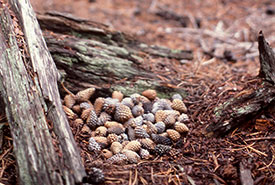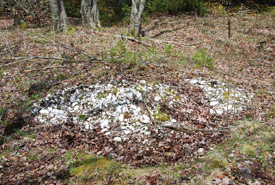Wildlife are found where they eat

Red squirrel cache (Photo by J. Schmidt/U.S. National Parks Service)
Middens are one of my favourite things to point out during a nature hike. Although more noticeable in the winter, they are a great way to see evidence of the presence of wildlife in an area, in every season.
You might be thinking, “What the heck are middens? Does she mean mittens, and if so, why are wildlife sporting trendy winter accessories?”
Middens, by early Scandinavian definition, are heaps of materials, such as bones, shells or stones. In a forest, however, middens are remnants of leftover food consumed by a species. Pieces of pine cone, shellfish fragments or torn bark are all examples of feeding evidence.
Middens can help you identify whether or not a species is present in an area ― especially if tracks aren’t present.
Get your printable copy of the Nature Conservancy of Canada (NCC) animal tracking guide here.
For example, shell and seed fragments or a half-eaten pine cone beside a tree can be evidence of species that are known to eat this type of food, such as a red or grey squirrel. With squirrels, middens or food caches can also be piles of food yet to be consumed, such as a big pile of cones.
For larger mammals, feeding evidence may include fur, shells or bones from other species. Other wildlife signs can include tree trunks where bark has been stripped off, or bushes where berries have been consumed ― often leaving a fruit-filled mess below!

An ancient shell midden in Port Joli. The clam shells on the surface indicate the site was previously damaged by artifact collectors. (Photo by Matthew Betts/Canadian Museum of History)
This type of feeding evidence has also been used to determine human activities in the past. Middens from species consumed by humans, such as shellfish and mammal bones, help identify feeding, hunting and gathering patterns. Middens from humans can also include charcoal from camp and cooking fires, stone, bone and shell fragments from tools and even pieces of leather and fur from clothing.
Read about the archeological discoveries and shell midden sites on NCC's land in Nova Scotia.
When you’re in nature, it’s important that only wildlife leave middens. Although middens from humans in the past help scientists learn more about our ancestors, humans of today should leave only footprints and take only memories from their outdoor adventures.
It’s difficult to use just middens to prove the existence of a species in an area. Feeding evidence should be used in conjunction with previous proof of a species’ existence in an area, such as tracks, sightings, scat or calls. By using middens, along with other wildlife evidence, such as tracks, you’re one step closer to becoming the Sherlock of the forest!


